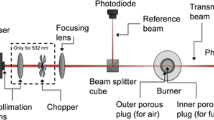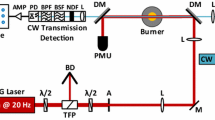Abstract
The optical properties of soot have been studied for many years with a particular attention focused on refractive index. In the present study, the two-excitation wavelength laser-induced incandescence technique has been applied to determine the ratio of the soot absorption function as a function of the wavelength. The advantage of this technique is to provide the determination of the E(m) ratio using a non-intrusive laser-based method without being disturbed by scattering. Measurements have been carried out in a methane premixed flat flame and in a diesel turbulent spray one. Four pairs of wavelength have been used to evaluate the spectral behavior of E(m) ratios from ultraviolet (UV) to near infrared (NIR). The two-excitation wavelength LII method implies heating soot the same way using two different laser excitations. Particular operating conditions must be selected to insure the equality of the LII signals, such an equality being necessary to derive the E(m) ratio. A laser excitation at 1064 nm has been chosen as a reference, and the obtained results have been compared with those issued from the use of UV and visible wavelengths of 266, 355, 532 and 660 nm. Results show a significant decrease of the E(m) ratio from UV to visible while it tends to become constant from 532 nm to NIR. The use of different experimental conditions allows to analyze the dependence of the E(m) ratios with the height above the burner, the fuel type and the soot temperature. No significant influence of these parameters has been pointed out on the relative E(m) values determined in the flame conditions investigated here.







Similar content being viewed by others
Abbreviations
- d p (m):
-
Soot primary particles diameter
- E(m, λ):
-
Soot absorption function
- F λ (J m−2):
-
Laser fluence
- E λ (J):
-
Total energy of the laser pulse radiation
- f v :
-
Soot volume fraction
- H abs (W):
-
Absorbed power of a single soot particle
- m = n − ik :
-
Optical index
- Q abs :
-
Soot absorption efficiency
- q λ (W m−2):
-
Laser irradiance
- S laser (m2):
-
Laser pulse cross-sectional area
- T (K):
-
Particle temperature
- λ (m):
-
Wavelength
- δ t (s):
-
Laser pulse duration
- Diester:
-
Diesel/rapeseed methyl ester (RME) mixture
- HAB:
-
Height above the burner
- LIF:
-
Laser-induced fluorescence
- LII:
-
Laser-induced incandescence
- PAH:
-
Polycyclic aromatic hydrocarbon
- TEM:
-
Transmission electron microscopy
- TiRe-LII:
-
Time-resolved LII
References
H. Horvath, Atmos. Environ. 27, 293–317 (1993)
T.T. Charalampopoulos, J.D. Felske, Combust. Flame 68(3), 283–294 (1987)
T.T. Charalampopoulos, H. Chang, B. Stagg, Fuel 68(9), 1173–1179 (1989)
S.S. Krishnan, K.-C. Lin, G.M. Faeth, ASME J. Heat Transf. 122(3), 517–524 (2000)
S.S. Krishnan, K.-C. Lin, G.M. Faeth, ASME J. Heat Transf. 123(2), 331–339 (2001)
W.H. Dalzell, A.P. Sarofim, ASME J. Heat Transf. 91(1), 100–104 (1969)
T.L. Henriksen, T.A. Ring, D. Call, E.G. Eddings, A.F. Sarofim, 5th U.S. Combustion Meeting, March 25–28th (2007)
J. Yon, R. Lemaire, E. Therssen, P. Desgroux, A. Coppalle, K.F. Ren, Appl. Phys. B 104(2), 253–271 (2010)
C.M. Sorensen, Aerosol Sci. Technol. 35, 648–687 (2001)
T.C. Bond, R.W. Bergstrom, Aerosol Sci. Technol. 40(1), 27–67 (2006)
D.R. Snelling, G.J. Smallwood, O.L. Glder, AIAA J. 40, 1789–1795 (2002)
D.R. Snelling, K.A. Thomson, G.J. Smallwood, Appl. Phys. B 96, 657–669 (2009)
B.F. Kock, B. Tribalet, C. Schulz, P. Roth, Combust. Flame 147, 79–92 (2006)
J. Reimann, S.A. Kuhlmann, S. Will, Appl. Phys. B 96, 583–592 (2009)
F. Liu, D.R. Snelling, K.A. Thomson, G.J. Smallwood, Appl. Phys. B 96, 623–636 (2009)
H. Chang, T.T. Charalampopoulos, Proc. R. Soc. Lond. Ser. A 430, 577–591 (1990)
S. Lee, C. Tien, Int. Symp. Combust. 18(1), 1159–1166 (1981)
Z.G. Habib, P. Vervisch, Combust. Sci. Technol. 59, 261–274 (1988)
T.H. Fletch, J. Ma, J.R. Rigby, A.L. Brown, B.W. Webb, Prog. Energy Combust. Sci. 23, 283–301 (1997)
H. Bladh, J. Johnsson, N.-E. Olofsson, A. Bohlin, P.E. Bengtsson, Proc. Combust. Inst. 33(1), 641–648 (2011)
T.L. Farias, M.G. Carvalho, Ü.Ö. Köylü, G.M. Faeth, J. Heat Transf. 117, 152–159 (1995)
CM. Sorensen, J. Cai, N. Lu, Langmuir 8, 2064–2069 (1992)
S. Manickavasagam, M.P. Meng, Appl. Opt. 36, 1337–1351 (1997)
E. Therssen, Y. Bouvier, C. S-Moreau, X. Mercier, P. Desgroux, M. Ziskind, C. Focsa, Appl. Phys. B 89, 417–427 (2007)
R. Lemaire, A. Faccinetto, E. Therssen, M. Ziskind, C. Focsa, P. Desgroux, Proc. Combust. Inst. 32, 737–744 (2009)
R. Lemaire, E. Therssen, P. Desgroux, Fuel 89, 3952–3959 (2010)
G. Cléon, T. Amodeo, A. Faccinnetto, P. Desgroux, Appl. Phys. B 104, 297–305 (2011)
R. Lemaire, S. Bejaoui, E. Therssen, Fuel 107, 147–161 (2013)
H.A. Michelsen, J. Chem. Phys. 118, 7012–7045 (2003)
R. Lemaire, M. Maugendre, T. Schuller, E. Therssen, J. Yon, Rev. Sci. Inst. 80, 105105–105113 (2009)
U. Koylu, G. Faeth, J.Heat Transf. 118(2), 415–421 (1996)
H.A. Michelsen, P.E. Schrader, F. Goulay, Carbon 48(8), 2175–2191 (2010)
H.A. Michelsen, P.E. Schrader, F. Goulay, Carbon 50(2), 740 (2012)
A. D’Anna, Proc. Combust. Inst. 32, 593–613 (2009)
S.De. Iuliis, S. Maffi, F. Cignoli, G. Zizak, Appl. Phys. B 102(4), 891–903 (2010)
F. Migliorini, S.De. Iuliis, S. Maffi, F. Cignoli, G. Zizak, Appl. Phys. B 96, 637–643 (2009)
Acknowledgements
This work was supported by the Air Quality Program of IRENI (Institut de Recherche en ENvironnement Industriel). The authors thank the Nord-Pas de Calais Region, the Centre Region, the European Funds for Regional Economic Development and the Centre d’Études et de Recherches Lasers et Applications (CERLA) for their financial support.
Author information
Authors and Affiliations
Corresponding author
Rights and permissions
About this article
Cite this article
Bejaoui, S., Lemaire, R., Desgroux, P. et al. Experimental study of the E(m, λ)/E(m, 1064) ratio as a function of wavelength, fuel type, height above the burner and temperature. Appl. Phys. B 116, 313–323 (2014). https://doi.org/10.1007/s00340-013-5692-y
Received:
Accepted:
Published:
Issue Date:
DOI: https://doi.org/10.1007/s00340-013-5692-y




